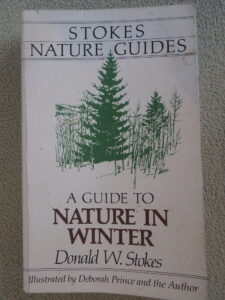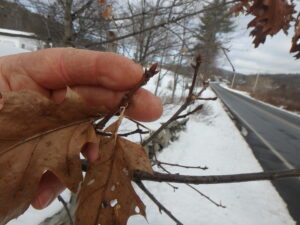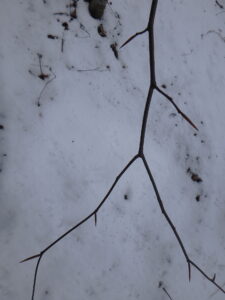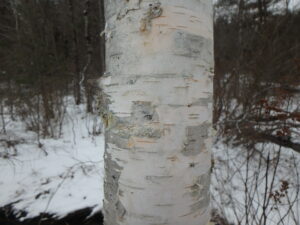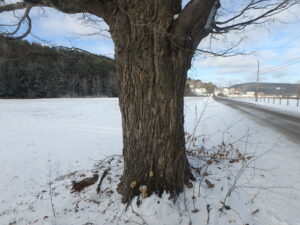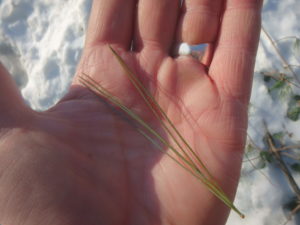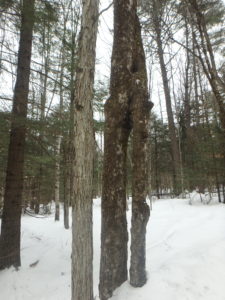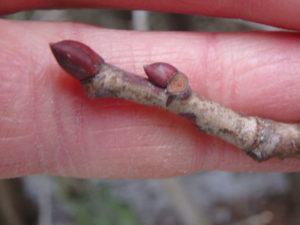A Guide to Nature in Winter
This is a good time to be outdoors exploring the fields and woods. There is so much to see that will be buried in snow later on. But you may ask, what is there to see? Trees, winter weeds, animal footprints, signs of insects, shelf fungi on trees, evergreen woodland plants and more. If I had to choose one person to show me the outdoors in winter, it would be Donald W. Stokes who wrote A Guide to Nature in Winter, that covers all these topics and more.
Donald Stokes’ book explains that if you learn to identify the six most common deciduous trees and the six most common trees with needles or cones, you will know 80% of the trees in most northern forests. And you can do this in winter. Bud location, size and shape are good indicators for identifying trees.
- Maples. Like ash trees, the buds, branches (and later leaves) are arranged opposite each other, while most other trees alternate the location of them on stems. Maples have oval buds that are between ¼ and ½ inch long.
- Ash. Buds on ash trees are larger than maple buds, and are dark and dome shaped. The twigs on ash trees are generally thicker than on maples.
- Oak.These have clusters of buds at the end of each branch, and the younger trees often hold onto their brown leaves through the winter. Buds and branches appear in an alternating pattern.
-
Beech. The buds on beech are long and pointy. But the most distinguishing characteristic is its smooth, gray bark. There is a beech fungal disease which can mar the bark, making it look like a bad case of acne.
- White Birch. Most people can recognize white birch by its bright, white and peeling bark, but other birch species can have golden or greyish bark. The bark also has long horizontal lines marking it, and they often have catkins hanging from the tips of upper branches.
- Poplar, also called aspen. These trees tend to grow in clumps in places with poor soil. The upper bark has a greenish tinge, and their buds are variable in color, but always have sharp, pointy ends.
- Pines.They have clumps of needles in groups of 2, 3 or 5. White pine, the most common, has groups of 5 long, soft needles.
- Hemlock. These trees have short (1/2-inch), soft needles with 2 white lines on the underneath side. There is a short stem between needle and twig.
- Balsam fir. One-inch needles, also with 2 white lines underneath but no stem between needle and twig.
- Cedar. Small, scale-like needles arranged along the twigs.
- Spruce. Four-sided needles that are uncomfortably sharp to the touch.
- Larch. No needles in winter, but cones may be present. Stubby twigs on branches.
If you pay attention to your trees, you will learn to identify them by shape and bark. Sugar maples, for instance, have nice rounded tops and older ones have craggy bark. I can identify a white pine from a fast- moving vehicle: branches on the lower part of the tree droop downward, upper branches reach for the sky.
Cleaning Up Your Landscape
Winter is a good time to look at the trees and shrubs on your property. Even though the snow may keep you from working on your trees, study your landscape now to see if you need to do some judicious tree removal or pruning before summer.
In nature trees grow willy-nilly. Where a seed lands is largely determined by chance. It is unable to know if it is 6 inches or 6 feet from another tree. If it germinates and grows it might be in a good place, or it might be smack-dab next to another tree – or your house.
If you have a wooded area on your property, it probably needs some help from you if you haven’t done any thinning or grooming of trees in recent years. Here’s what you can do – your garden project for the week: go outside and really look at the trees growing on your property with a critical eye. Take note of spacing, in particular.
Ask yourself these questions as you walk around your property (or look out the window) at your trees: what is the future of this tree? How big do examples of this tree grow to be? What will this one look like in 10 years? In 50? Is it too close to its neighboring trees or to the house? Are there trees crowding it that you need to remove?
I’m a tree-hugger but I have no problem with cutting down trees when judicious thinning is beneficial. Now is the time to plan on some careful thinning of trees, and marking those that need to be removed to improve the health of others. A roll of bright colored surveyors tape to tie around trees will help you find any that you plan to remove.
Before you start tagging trees for culling you need to learn to identify the trees on your property, another good winter project. “A Guide to Nature in Winter” by Donald Stokes is a wonderful book that will help you with that. Because there are no leaves on most trees out there now, the Stokes book is great – it identifies trees by their bark, shape, branching and buds.
Stokes notes that if you learn a few common trees, you will be able to identify 80% of all trees in the New England landscape. Those trees are oak, maple, ash, beech, birch and poplar, along with hemlock and white pine. It also teaches much about all the other living things out there in the woods – from snow fleas to deer and everything in between.
Trees that I cull from my woods include poplars (Populus spp.), boxelder (Acer negundo) and alders (Alnus spp.). These are fast-growing trees that are short-lived and that produce lots of seedlings. They lack majesty.
Trees that I revere are sugar maples, oaks, beech, birches and hophornbeam (Carpinus caroliniana). I would think long and hard about cutting down one of them. But trees need plenty of space to do well, so sometimes it is necessary to remove a young one.
Invasive shrubs I remove include bush honeysuckle, barberry and burning bush. Those are on the list of invasive in most New England states. All of those can choke out native shrubs and even many native wildflowers. I work on eliminating those two every spring, but they are still ahead of me. Learn to identify them and tag them for spring removal.
So put on your snowshoes and get outside. And if you can get a copy of the Stokes Guide to Nature in Winter, you’ll learn much and have a grand time.
Henry lives and gardens in Cornish Flat, NH. His e-mail is henry.homeyer@comcast.net.



